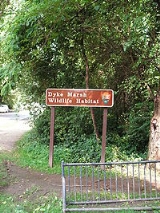
Dyke Marsh
Encyclopedia
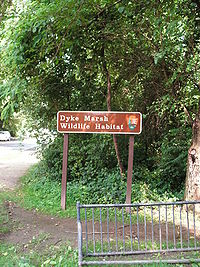
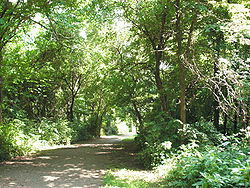
Potomac River
The Potomac River flows into the Chesapeake Bay, located along the mid-Atlantic coast of the United States. The river is approximately long, with a drainage area of about 14,700 square miles...
south of Alexandria
Alexandria, Virginia
Alexandria is an independent city in the Commonwealth of Virginia. As of 2009, the city had a total population of 139,966. Located along the Western bank of the Potomac River, Alexandria is approximately six miles south of downtown Washington, D.C.Like the rest of northern Virginia, as well as...
, Virginia
Virginia
The Commonwealth of Virginia , is a U.S. state on the Atlantic Coast of the Southern United States. Virginia is nicknamed the "Old Dominion" and sometimes the "Mother of Presidents" after the eight U.S. presidents born there...
between Old Town Alexandria and Mount Vernon
Mount Vernon, Virginia
Mount Vernon is a census-designated place in Fairfax County, Virginia, United States. Nearby CDPs are Fort Belvoir , Groveton, Virginia and Hybla Valley, Virginia , and Fort Hunt, Virginia...
. Dyke Marsh consists of about 380 acres (1.5 km²) of tidal marsh, floodplain
Floodplain
A floodplain, or flood plain, is a flat or nearly flat land adjacent a stream or river that stretches from the banks of its channel to the base of the enclosing valley walls and experiences flooding during periods of high discharge...
, and swamp forest. Forming 5,000 to 7,000 years ago, Dyke Marsh is the largest remaining piece of freshwater tidal wetlands left in the Baltimore-Washington Metropolitan Area
Baltimore-Washington Metropolitan Area
The Baltimore-Washington Metropolitan Area is a combined statistical area consisting of the overlapping labor market region of the cities of Baltimore, Maryland and Washington, D.C.. The region includes Central Maryland, Northern Virginia, and Jefferson County in the Eastern Panhandle of West...
. The marsh is managed by the National Park Service
National Park Service
The National Park Service is the U.S. federal agency that manages all national parks, many national monuments, and other conservation and historical properties with various title designations...
. Dyke Marsh contains a wide array of plant and animal life. "Haul Road" is a trail that leads visitors into the marsh. It is frequented by area birdwatchers. Dyke Marsh is located off the George Washington Memorial Parkway
George Washington Memorial Parkway
The George Washington Memorial Parkway, known to local motorists simply as the "G.W. Parkway", is a parkway maintained by the U.S. National Park Service. It is located mostly in Northern Virginia, although a short section northwest of the Arlington Memorial Bridge passes over Columbia Island,...
at the Belle Haven Marina exit.
Here the fresh water of the upper Potomac mixes with the salt water of the lower Potomac. The fresh water tends to float above the tidal salt water producing a tidal freshwater marsh.
Name
Dyke Marsh got its name because it was within a dike at one point. Earthen walls were built around the perimeter of the marsh in the 19th century to create more "fast land," land not inundated by tides. This land was used for farming purposes, mainly to graze livestock or to grow crops.One of the oldest photographs of Dyke Marsh is a circa 1909 picture postcard created for the Alexandria-Mt. Vernon trolley line
Northern Virginia trolleys
The earliest electric railway, or streetcar line, in Northern Virginia opened in 1892. At their peak, when merged into a single interurban system , the successors of this and several other lines ran between downtown Washington, D.C., Rosslyn and Arlington Junction – present day Crystal City...
(whose light rail tracks were replaced by the George Washington Memorial Parkway in 1932.) The ca. 1909 photograph is labelled: The "Dyke," a favorite resort for fishermen and hunters on the line of the Mt. Vernon Railroad, near Alexandria, Va.
Wildlife
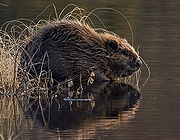
Beaver
The beaver is a primarily nocturnal, large, semi-aquatic rodent. Castor includes two extant species, North American Beaver and Eurasian Beaver . Beavers are known for building dams, canals, and lodges . They are the second-largest rodent in the world...
population is visible along the "Haul Road" and muskrat
Muskrat
The muskrat , the only species in genus Ondatra, is a medium-sized semi-aquatic rodent native to North America, and introduced in parts of Europe, Asia, and South America. The muskrat is found in wetlands and is a very successful animal over a wide range of climates and habitats...
have been spotted numerous times. Little brown bat
Little brown bat
The little brown bat is a species of the genus Myotis , one of the most common bats of North America...
s and red fox
Red Fox
The red fox is the largest of the true foxes, as well as being the most geographically spread member of the Carnivora, being distributed across the entire northern hemisphere from the Arctic Circle to North Africa, Central America, and the steppes of Asia...
can be seen at night. Cottontail rabbit
Cottontail rabbit
The cottontail rabbits are among the 16 lagomorph species in the genus Sylvilagus, found in the Americas.In appearance, most cottontail rabbits closely resemble the wild European Rabbit...
, gray squirrel
Gray squirrel
Gray squirrel or grey squirrel may refer to several species of squirrel indigenous to North America:*The Eastern gray squirrel , from the eastern United States and southeastern Canada; introduced into Britain, Ireland, western North America, Italy, and South Africa;*The Western Gray Squirrel , from...
s, shrews, and field mice (the vole
Vole
A vole is a small rodent resembling a mouse but with a stouter body, a shorter hairy tail, a slightly rounder head, smaller ears and eyes, and differently formed molars . There are approximately 155 species of voles. They are sometimes known as meadow mice or field mice in North America...
) can also be found in and around the marsh. The most obvious inhabitant of Dyke Marsh is the Red-winged Blackbird
Red-winged Blackbird
The Red-winged Blackbird is a passerine bird of the family Icteridae found in most of North and much of Central America. It breeds from Alaska and Newfoundland south to Florida, the Gulf of Mexico, Mexico, and Guatemala, with isolated populations in western El Salvador, northwestern Honduras, and...
, with its distinct call. The Red-winged Blackbird nests among the cattails and feeds on insects and seeds. Nearly 300 species of birds have been seen in Dyke Marsh. It is known as one of the best birdwatching
Birdwatching
Birdwatching or birding is the observation of birds as a recreational activity. It can be done with the naked eye, through a visual enhancement device like binoculars and telescopes, or by listening for bird sounds. Birding often involves a significant auditory component, as many bird species are...
sites in the Washington Metropolitan Area
Washington Metropolitan Area
The Washington Metropolitan Area is the metropolitan area centered on Washington, D.C., the capital of the United States. The area includes all of the federal district and parts of the U.S...
. The lower Potomac is a natural migration route, especially for water birds.
Plants
More than 360 species of plants have been found at Dyke Marsh. The narrow-leafed cattail is the dominant species in the area. It normally develops its characteristic flower spike by June. Many other species of plant occupy the marsh including several types of SagittariaSagittaria
Sagittaria is a genus of about 30 species of aquatic plants whose members go by a variety of common names, including arrowhead, duck potato, iz-ze-kn, katniss, kuwai , swan potato, tule potato, and wapato...
, arrow arum, pickerelweed, sweetflag, spatter-pond lily, and Northern Wild Rice. The rice attracts animals such as the Red-winged Blackbird and waterfowl
Waterfowl
Waterfowl are certain wildfowl of the order Anseriformes, especially members of the family Anatidae, which includes ducks, geese, and swans....
.
Changes

Erosion
Erosion is when materials are removed from the surface and changed into something else. It only works by hydraulic actions and transport of solids in the natural environment, and leads to the deposition of these materials elsewhere...
is noticeable along the Haul Road, showing that the dredging is still making an impact. Human influences has also led to the introduction of several types of exotic, or non-native, plants to the marsh. These plants are very opportunistic and often outcompete beneficial native species of plants. Exotic vines, such as the Asian porcelain berry, Japanese honeysuckle
Japanese Honeysuckle
The Japanese Honeysuckle is a species of honeysuckle native to eastern Asia including China , Japan, and Korea. It is a twining vine able to climb up to high or more in trees, with opposite, simple oval leaves long and broad...
, and Asiatic bittersweet have begun smothering parts the floodplain forest. Yellow iris and the common reed are exotic plants that now inhabit the actual marsh. Efforts are being made to prevent the introduction of the purple loosestrife
Purple loosestrife
Lythrum salicaria is a flowering plant belonging to the family Lythraceae, native to Europe, Asia, northwest Africa, and southeastern Australia. It should not be confused with other plants sharing the name loosestrife that are members of the family Primulaceae...
.
Uses
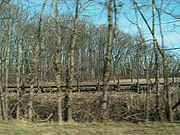
George Washington Memorial Parkway
The George Washington Memorial Parkway, known to local motorists simply as the "G.W. Parkway", is a parkway maintained by the U.S. National Park Service. It is located mostly in Northern Virginia, although a short section northwest of the Arlington Memorial Bridge passes over Columbia Island,...
and the Mount Vernon Trail
Mount Vernon Trail
The Mount Vernon Trail is a popular running and bike path in Northern Virginia that follows the west bank of the Potomac River from near Theodore Roosevelt Island to Mount Vernon. The northern, urban half is open and has views of Washington, D.C. across the river. The southern below Alexandria is...
. Thousands of bicyclists, walkers, and runners go through Dyke Marsh on a weekly basis on the Mount Vernon Trail. Just off of the trail, there is a sitting area on a boardwalk over the marsh. The interior path is J-shaped and goes south from the marina entrance and then turns east onto a peninusla. Birdwatchers, animal lovers, and nature enthusiasts often visit the sitting area in an effort to catch a glimpse of what Dyke Marsh has to offer. Some people like to visit the marsh at night to watch the fireflies as they dance along the marsh and in the trees. Often, high school students take to Dyke Marsh on weekend nights to participate in underage drinking.

